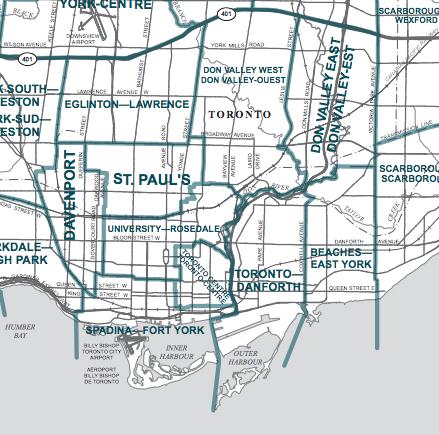The Federal Electoral Boundaries Commission for Ontario has listened to concerns from the community and maintained the integrity of the Church Wellesley Village in a single riding in its final report to be tabled to Parliament.
Previously, the commission had proposed that the part of the Village north of Wellesley Street would be swept into a new riding called Mount Pleasant that stretched up to Eglinton, capturing many wealthy neighbourhoods, such as Rosedale and Moore Park.
The old proposal had very little support and drew criticism from several people who appeared at a public hearing into the new boundaries last year. The new proposal leaves the Village entirely within Toronto Centre and leaves out the proposed Mount Pleasant riding.
Instead, the commission appears to have listened to the proposal made by several deputants, including several MPs and MPPs, that the new riding in downtown Toronto be created along the waterfront, capturing the booming new condo neighbourhoods that continue to grow south of the Gardiner Expressway.
The proposed new riding, called Spadina-Fort York, incorporates the section of the current Toronto Centre riding south of Front Street and The Esplanade and the section of the current Trinity-Spadina riding south of Dundas Street. The new riding currently has a below-average population, which should leave it room to accommodate the strong growth happening in the area.
Toronto Centre also loses territory to the proposed new University-Rosedale riding, mostly made up of the section of Trinity-Spadina north of Dundas, plus the section of Toronto Centre north of Charles Street East and the sections west of Bay Street that make up part of the University of Toronto campus and residences.
It’s unclear how the proposal will affect electoral outcomes at this point, particularly as the NDP wave in the 2011 election demolished several longstanding Liberal strongholds. However, the loss of the Liberal-Conservative voting area north of Bloor Street East and the Liberal-leaning waterfront area could strengthen NDP odds in Toronto Centre.
Conversely, the loss of the southern section of Chinatown, which has voted heavily for NDP MP Olivia Chow in recent elections, and the addition of Rosedale could put University-Rosedale into play for the Liberals.
Judging by the most recent electoral results, the NDP would most likely take Spadina-Fort York as well, although Liberal candidates dominated the area in previous elections.
Of course, as 2011 bore out, a surprising campaign turn or a star candidate can make all prognostications moot.
In the 2015 election, both the NDP and the Liberals will have new leaders. Tom Mulcair will lead his first campaign as NDP leader, while the Liberals will elect their new leader in April.
A parliamentary committee will be able to file objections to the proposal through March. Any objections must be considered by the commission, which may incorporate or reject their concerns. The commission will make its final recommendations in September.
Federal riding redistributions happen every 10 years so that ridings will have roughly equal populations according to the decennial census. This year’s redistribution was complicated by a new law that expanded Parliament, creating 15 new ridings in Ontario, six each in British Columbia and Alberta, and three in Quebec.
The redistribution has knock-on effects for provincial representation, as provincial ridings in Southern Ontario are largely defined to be coterminous with federal ridings. The new ridings could not be used in a provincial election before April 2014. As Ontario currently has a minority government, it is unclear when the next general election will be held.
See the Federal Boundary Commission’s report here.


 Why you can trust Xtra
Why you can trust Xtra


